算法(第四版)C# 习题题解——3.2
写在前面
整个项目都托管在了 Github 上:https://github.com/ikesnowy/Algorithms-4th-Edition-in-Csharp
查找更方便的版本见:https://alg4.ikesnowy.com/
这一节内容可能会用到的库文件有 BinarySearchTree,同样在 Github 上可以找到。
善用 Ctrl + F 查找题目。
习题&题解
3.2.1
解答
构造出的树如下图所示:
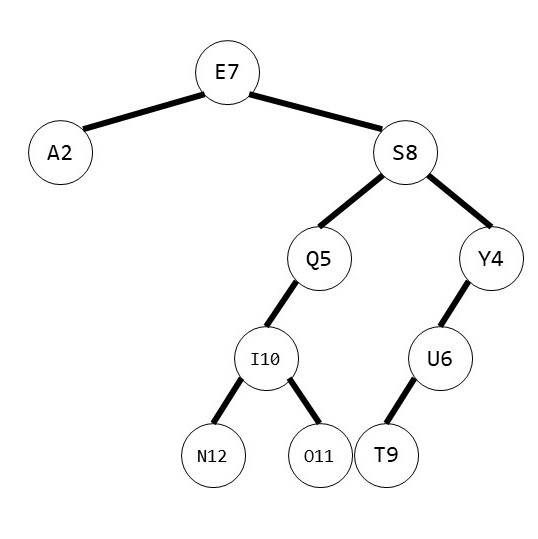
总比较次数:0 + 1 + 1 + 2 + 2 + 3 + 1 + 2 + 4 + 3 + 4 + 5 = 28 次
另请参阅
3.2.2
解答
用这样的序列就可以构造出最坏情况:
"A X C S E R H",
"X A S C R E H",
"A C E H R S X",
"X S R H E C A",
"X A S R H E C",
"A X S R H E C"
构造出来的树看起来像这样:
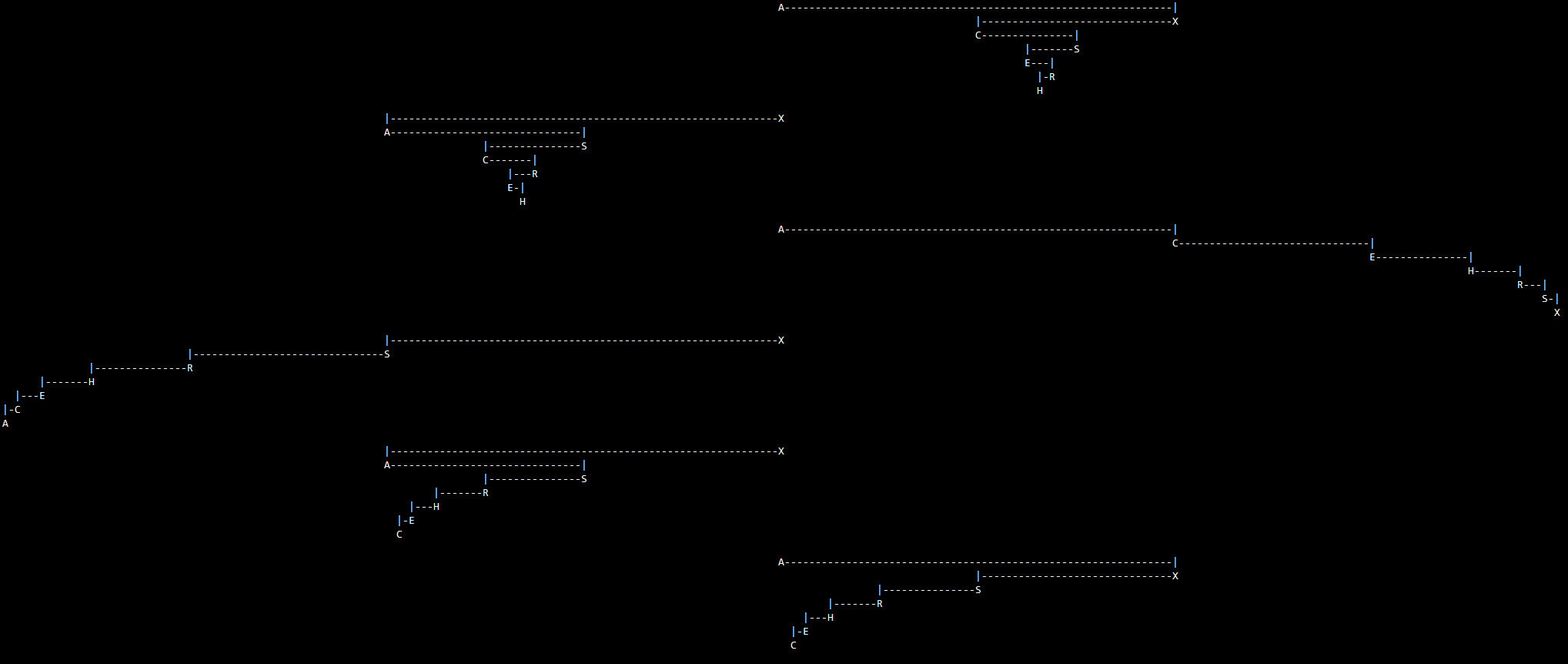
3.2.3
解答
官方答案:第一个插入的是 H,且 C 在 A 和 E 之前插入,S 在 R 和 X 之前插入的树。
对序列排序,得到 A C E H R S X 。
最优情况需要树两侧平衡,因此 H 为根结点,C 和 S 分别为 H 的子结点。
同理,A 和 E 为 C 的子结点,R 和 X 为 S 的子结点。
3.2.4
解答
d 是错误的。
要点是追踪序列中的左右顺序,
如果向右查找,那么后面的树一定都比它大,反之都比它小。
例如 d 选项,2->7 向右查找,但后面的 8 比 7 大,应该挂在 7 的右子树上,不可能在 7 的左子树里。
3.2.5
解答
事实上,这个问题可以归结为,如何根据频率来构造一棵最优的BST?
如果知道树的形状,逆推插入顺序也就不难了(先序遍历)。
首先我们定义某个结点的查找开销为该结点的深度加一乘以频率,
(注意根结点的深度为 0,树的高度等于整棵树中最大的深度值)
所有结点的查找开销加起来就是一整棵树的查找开销了。
对于固定的一组键值和频率,$ cost $ 最小的树即为我们要找的树。
这样的树被称为最优化二叉树,或者 Optimal BST。
根据二叉树的性质,我们可以将 $ cost $ 的表达式变为:
即左子树的开销和右子树的开销相加,再加上所有结点的频率之和。
(左子树和右子树开销计算时每个结点的深度都少了1,因此要加上频率和)
不难得到结论,Optimal BST 的所有子树也都是 Optimal BST。
我们可以利用一种类似于构造哈夫曼树的方法构造 Optimal BST,
哈夫曼树中比较的是频率,而构造 Optimal BST 时比较的则是开销。
由于二叉查找树是有序的,因此我们先对序列排序。
然后计算所有大小为 1 的子树开销,显然就等于各个节点的频率。
再计算大小为 2 的子树,注意这里只能按顺序取结点,不能跳着取(例如取第一个和第三个结点),
每种结点取法都对应有两种根结点选择,计算出最小的开销并记录。
以此类推,直到计算到大小为 n 的树,此时整棵 BST 就被构造出来了。
举个例子,例如给出键值和频率如下表所示:
| 键值 | 1 | 2 | 3 | 4 | 5 |
|---|---|---|---|---|---|
| 频率 | 0.4 | 0.1 | 0.2 | 0.1 | 0.2 |
当 $ s=1 $ 时,各子树的开销如下表(根结点不唯一):
| 子树 | [1,1] | [2,2] | [3,3] | [4,4] | [5,5] |
|---|---|---|---|---|---|
| 开销 | 0.4 | 0.1 | 0.2 | 0.1 | 0.2 |
| 根结点 | 1 | 2 | 3 | 4 | 5 |
当 $ s=2 $ 时,各个子树的开销如下(根结点不唯一):
| 子树 | [1,2] | [2,3] | [3,4] | [4,5] |
|---|---|---|---|---|
| 开销 | $ \min \begin{cases} 0+[2,2]+0.5, \\ [1,1]+0+0.5, \end{cases} \\ =0.6 $ | $ \min \begin{cases} 0+[3,3]+0.3, \\ [2,2]+0+0.3, \end{cases} \\ =0.4 $ | $ \min \begin{cases} 0+[4,4]+0.3, \\ [3,3]+0+0.3, \end{cases} \\ =0.4 $ | $ \min \begin{cases} 0 +[5,5]+0.3, \\ [4,4]+0+0.3, \end{cases} \\ =0.4 $ |
| 根结点 | 1 | 3 | 3 | 5 |
当 $ s=3 $ 时,各个子树的开销如下表(根结点不唯一):
| 子树 | [1,3] | [2,4] | [3,5] |
|---|---|---|---|
| 开销 | $ \min \begin{cases} 0+[2,3]+0.7, \\ [1,1]+[3,3]+0.7, \\ [1,2]+0+0.7, \end{cases} \\ =1.1 $ | $ \min \begin{cases} 0+[3,4]+0.4, \\ [2,2]+[4,4]+0.4, \\ [2,3]+0+0.4, \end{cases} \\ =0.6 $ | $ \min \begin{cases} 0+[4,5]+0.5, \\ [3,3]+[5,5]+0.5, \\ [3,4]+0+0.5, \end{cases} \\ =0.9 $ |
| 根结点 | 1 | 3 | 3 |
当 $ s=4 $ 时,各个子树的开销如下表(根结点不唯一):
| 子树 | [1,4] | [2,5] |
|---|---|---|
| 开销 | $ \min \begin{cases} 0+[2,4]+0.8, \\ [1,1]+[3,4]+0.8, \\ [1,2]+[4,4]+0.8, \\ [1,3]+0+0.8, \end{cases} \\ = 1.4 $ | $ \min \begin{cases} 0+[3,5]+0.5, \\ [2,2]+[4,5]+0.5, \\ [2,3]+[5,5]+0.5, \\ [2,4]+0+0.5, \end{cases} \\ = 1.0 $ |
| 根结点 | 1 | 3 |
当 $ s=5 $ 时,各个子树的开销如下表(根结点不唯一):
| 子树 | [1,5] |
|---|---|
| 开销 | $ \min \begin{cases} 0+[2,5]+1.0, \\ [1,1]+[3,5]+1.0, \\ [1,2]+[4,5]+1.0, \\ [1,3]+[5,5]+1.0, \\ [1,4]+0+1.0 \end{cases} \\ = 2.0 $ |
| 根结点 | 1 |
于是最优二叉树为(不唯一):

另请参阅
Optimal Binary Search Tree - Wikipedia
3.2.6
解答
官方 BST 实现见:https://algs4.cs.princeton.edu/32bst/BST.java.html
二叉树的高度=左右子树最大高度+1,叶结点的高度为 0。
于是我们可以构造如下递归方法:
private int Height(Node x)
{
return x == null ? -1 : 1 + Math.Max(Height(x.Left), Height(x.Right));
}
当 x 等于 null 时,说明它是叶子结点的左/右子树,应该返回 0-1=-1。
也可以在结点中添加一个 Height 属性,记录当前结点的高度,当插入新结点时重新计算高度。
在 Put 方法中添加计算高度的代码:
private Node Put(Node x, TKey key, TValue value)
{
if (x == null)
return new Node(key, value, 1, 0);
int cmp = key.CompareTo(x.Key);
if (cmp < 0)
x.Left = Put(x.Left, key, value);
else if (cmp > 0)
x.Right = Put(x.Right, key, value);
else
x.Value = value;
x.Size = 1 + Size(x.Left) + Size(x.Right);
x.Height = 1 + Math.Max(Height(x.Left), Height(x.Right));
return x;
}
由于叶结点的高度为零,因此新插入的结点高度应该初始化为 0。
3.2.7
解答
平均查找次数 = 树所有结点的深度之和 / 结点个数 + 1。
只要能够获得深度和,就能构造出如下用于计算平均查找次数的方法:
public int AverageCompares()
{
return DepthSum(root) / Size() + 1;
}
二叉树的深度之和 = 左子树的深度和 + 右子树的深度和 + 左子树的结点个数 + 右子树的结点个数
(加上根结点会使左右子树所有结点的深度+1)
于是我们可以获得如下递归方法,用于计算一棵树的深度和:
private int DepthSum(Node x)
{
if (x == null)
return 0;
return DepthSum(x.Left) + DepthSum(x.Right) + x.Size - 1;
}
也可以在结点中直接添加一个 DepthSum 属性,用于记录当前结点的深度和。
需要在每次插入新结点时重新计算查找路径上所有结点的 DepthSum。
private Node Put(Node x, TKey key, TValue value, int depth)
{
if (x == null)
return new Node(key, value, 1, depth);
var cmp = key.CompareTo(x.Key);
if (cmp < 0)
x.Left = Put(x.Left, key, value, depth + 1);
else if (cmp > 0)
x.Right = Put(x.Right, key, value, depth + 1);
else
x.Value = value;
x.Size = 1 + Size(x.Left) + Size(x.Right);
x.DepthSum = depth;
if (x.Left != null)
x.DepthSum += x.Left.DepthSum;
if (x.Right != null)
x.DepthSum += x.Right.DepthSum;
return x;
}
在插入结点时需要传入一个参数以记录当前深度,新插入结点的默认深度和就是当前深度。
3.2.8
解答
假设输入的完全二叉树结点数目为 \(n\)。
完全二叉树总是可以分成两部分,一个满二叉树,以及多余的结点。
于是完全二叉树中满二叉树的部分层数为 \(l = \lfloor \log_2 (n+1) \rfloor\)。(根结点位于第一层)
满二叉树占的结点数量为 \(n_1 = 2^l -1\),多余结点数量为 $ n_2=n-n_1$。
又因为深度等于层数 - 1,多余结点正好在满二叉树的下一层,因此多余结点的深度即为 $ l $。
于是多余结点的深度和 \(d_2 = l \times n_2\)。
接下来计算满二叉树的深度和。
一个层数为 $ l $ 的满二叉树,最后一层正好有 $ 2^{l-1} $ 个结点。
于是深度和为 $ d_1 = 0 \times 1 + 1 \times 2+2 \times 4+\cdots+(l-1)2^{l-1} =\sum_{i=1}^{l-1} i2^i $。
用错位相减法,有:
于是可得总深度和: \(d=d_1+d_2=l\times n_2+ (l-2)2^l+2\)。
平均查找次数即为:\(avgCompare=d / n + 1\) 。
代码
private static int OptCompares(int n)
{
// 完全二叉树 = 满二叉树 + 多余结点
// 满二叉树的层数。
var l = (int)Math.Log(n + 1, 2);
// 多余结点的个数。
var extraNodes = n + 1 - (int)Math.Pow(2, l);
var depthSum =
extraNodes * l + (l - 2) * (int) Math.Pow(2, l) + 2;
return depthSum / n + 1;
}
3.2.9
解答
比较简单,可以按照如下步骤解决:
- 生成 n 个数。
- 生成这 n 个数的全排列。
- 生成 n! 棵二叉搜索树,取其中结构不同的部分。
全排列可以通过递归方式生成,方法类似于 DFS。
开始 pool 中存有所有的数,遍历 pool ,每次取一个数放入 path 中,然后递归选择下一个。
static void Permutation(List<int> pool, List<int> path, List<int[]> result)
{
if (pool.Count == 0)
{
result.Add(path.ToArray());
return;
}
for (var i = 0; i < pool.Count; i++)
{
var item = pool[i];
path.Add(item);
pool.RemoveAt(i);
Permutation(pool, path, result);
pool.Insert(i, item);
path.Remove(item);
}
}
有了 n! 棵二叉树之后,我们需要过滤掉结构相同的树。
我们可以把二叉树转换成数组表示(层序遍历即可),然后遍历数组进行比较。
var treeA = a.ToArray();
var treeB = b.ToArray();
if (treeA.Length != treeB.Length)
return false;
for (var i = 0; i < treeA.Length; i++)
{
if (treeA[i] == null && treeB[i] == null)
continue;
if (treeA[i] != null && treeB[i] != null)
continue;
return false;
}
return true;
结果如下:
n=2
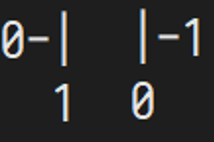
n=3
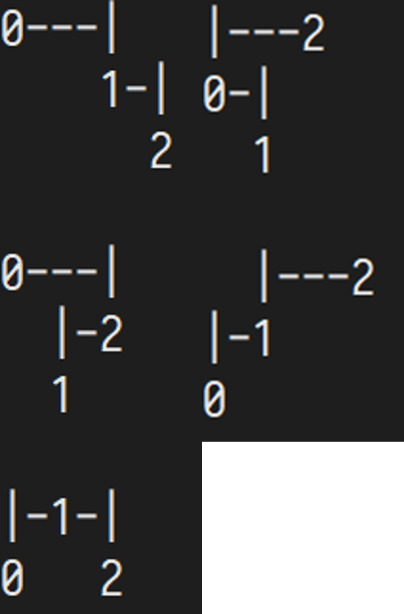
n=4

n=5
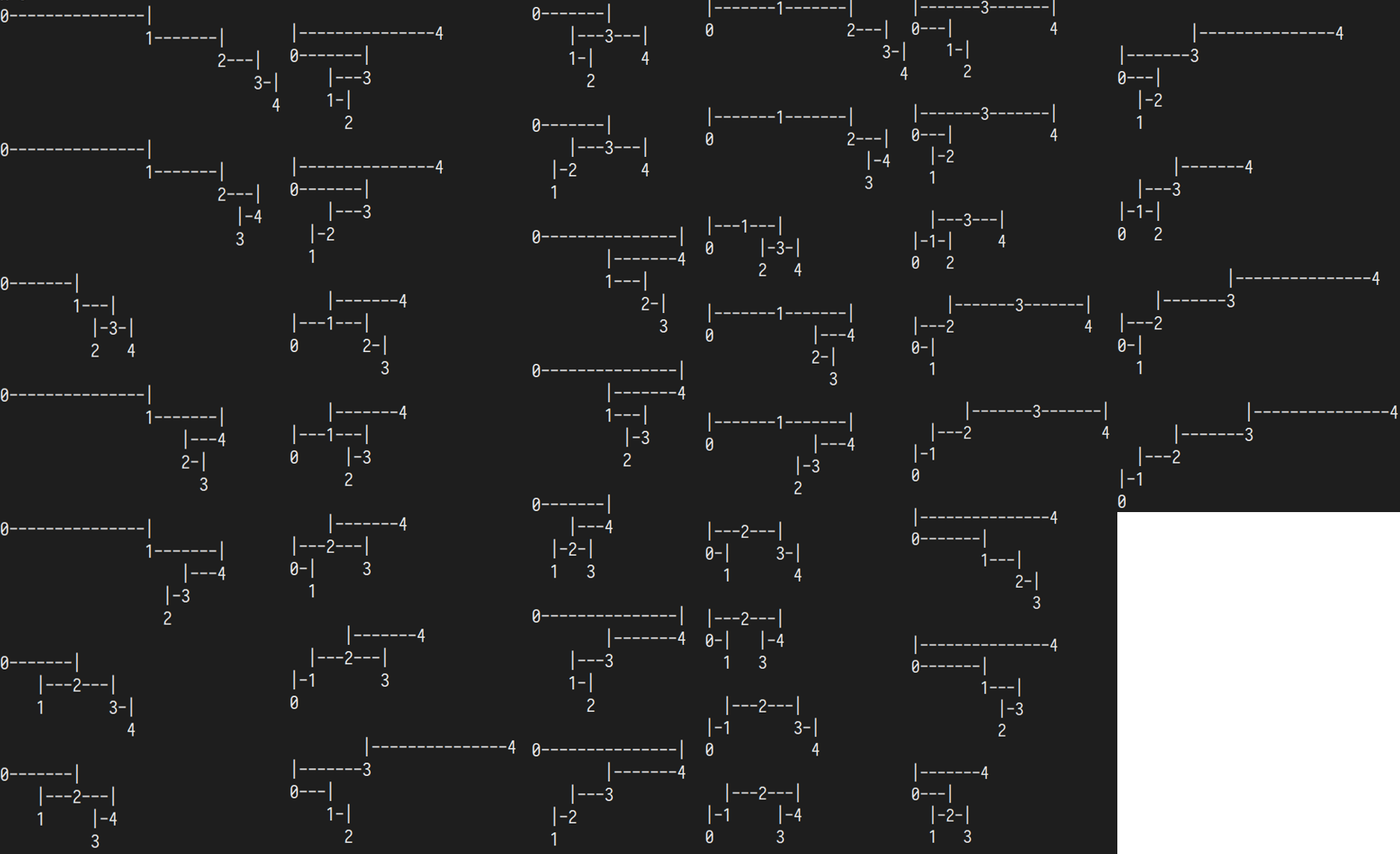
n=6


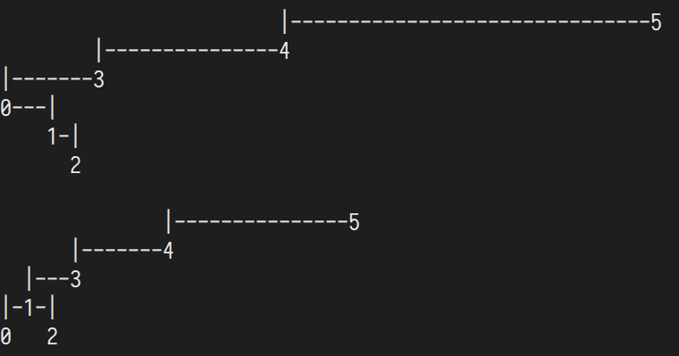
另请参阅
3.2.10
解答
官方实现:https://algs4.cs.princeton.edu/32bst/TestBST.java.html
测试结果:
size = 10
min = A
max = X
Testing keys()
---------------------------
A 8
C 4
E 12
H 5
L 11
M 9
P 10
R 3
S 0
X 7
Testing select
---------------------------
0 A
1 C
2 E
3 H
4 L
5 M
6 P
7 R
8 S
9 X
key rank floor ceil
---------------------------
A 0 A A
B 1 A C
C 1 C C
D 2 C E
E 2 E E
F 3 E H
G 3 E H
H 3 H H
I 4 H L
J 4 H L
K 4 H L
L 4 L L
M 5 M M
N 6 M P
O 6 M P
P 6 P P
Q 7 P R
R 7 R R
S 8 S S
T 9 S X
U 9 S X
V 9 S X
W 9 S X
X 9 X X
Y 10 X
Z 10 X
range search
---------------------------
A-Z (11)A C E H L M P R S X
Z-A (0)
X-X (1)X
0-Z (11)A C E H L M P R S X
B-G (3)C E
C-L (4)C E H L
After deleting the smallest 3 keys
---------------------------
H 5
L 11
M 9
P 10
R 3
S 0
X 7
After deleting the remaining keys
---------------------------
After adding back the keys
---------------------------
A 8
C 4
E 12
H 5
L 11
M 9
P 10
R 3
S 0
X 7
3.2.11
解答
树的高度为树中深度最大的点的深度。
因此 N 个结点最多只能构造出高度为 N-1 的树来,并不能构成高度为 N 的树。
如果将题目变为用 N 个结点构造高度为 N-1 的二叉搜索树。
这样的树即为二叉搜索树的最坏情况,除唯一的叶子结点之外,每个结点有且只有一个子树。
于是除根结点外,每个结点都有两种选择,要么在左,要么在右。
因此共有 \(2 ^ {n - 1}\) 种形状。
接下来证明,对于某一种确定的最坏情况,在 N 个元素各不相同的情况下,输入顺序是唯一的。
证明:
就 1 2 3 这三个元素而言,构造这样一棵树:
2
1 3
可以有 2 1 3 和 2 3 1 两种序列,因为在插入 2 之后可以选择的位置有两个
但最坏情况下的二叉搜索树不存在具有两个子结点的结点,因此输入顺序是唯一的。
反证:
也可以这样考虑,假设序列 A 可以构造出一棵最坏情况下的二叉树,插入顺序为 \(x_1 \dots x_n\)
假设存在与 A 顺序不同的序列 B,它构造出的二叉树与 A 的相同。
由于 A 和 B 的元素相同,因此 A 必然可以通过有限次元素交换得到 B。
根据最坏情况下的二叉搜索树的性质,A 中的元素 \(x_n\) 必然满足 \(x_1 \dots x_{n - 1}\) 的所有关系。
例如,假设 \(x_1 > x_2\), 则 $ x_3 $ 也必然满足 \(x_1 > x_3\),即后面的元素必然满足前面元素的关系。
于是 A 存在关系序列 \(r_1 \dots r_{n - 1}\),只有满足这样序列的输入才能构造出对应的二叉树。
(可以将 \(r\) 理解为大于号或者小于号,由于元素各不相同,因此不存在等号)
显然 A 中的任意两个元素交换会导致至少一个 \(r\) 倒置,除非进行逆向交换,否则这种倒置不可能消除。
(大于号和小于号是不满足交换律的)
因此 A 和 B 必定相同,得证。
于是每一种最坏情况下的形状都唯一对应一种输入序列,共有 \(2 ^ {n - 1}\) 种构造方式。
3.2.12
解答
二叉树的大小=左子树的大小+右子树的大小+1
根据上述表达式可以构造出一个递归的 Size() 方法,并删除结点中的 Size 。
Rank() 和 Select() 仍然可以正常工作,但最坏情况下的耗时可能会达到 \(O(n)\) 和 \(O(n^2)\)。
3.2.13
解答
官方实现:https://algs4.cs.princeton.edu/32bst/NonrecursiveBST.java.html
Get 方法可以很方便的改成非递归形式。
while (cur != null)
{
var cmp = key.CompareTo(cur.Key);
if (cmp < 0)
cur = cur.Left;
else if (cmp > 0)
cur = cur.Right;
else
return cur.Value;
}
Put 方法结构类似,但需要注意更新路径上各个结点的 Size 属性。
var path = new Stack<Node>();
var cur = x;
while (cur != null)
{
path.Push(cur);
var cmp = key.CompareTo(cur.Key);
if (cmp < 0)
cur = cur.Left;
else if (cmp > 0)
cur = cur.Right;
else
{
cur.Value = value;
return x;
}
}
var parent = path.Peek();
var node = new Node(key, value, 1);
if (parent.Key.CompareTo(key) > 0)
parent.Left = node;
else
parent.Right = node;
while (path.Count > 0)
path.Pop().Size++;
Keys 方法中,可以用新建一个栈来代替递归栈记录路径。
while (x != null || stack.Count > 0)
{
if (x != null)
{
stack.Push(x);
x = x.Left;
}
else
{
x = stack.Pop();
queue.Enqueue(x.Key);
x = x.Right;
}
}
另请参阅
3.2.14
解答
就 min,max 和 select 而言,它们是尾递归的,可以直接转换成迭代形式。
(简单的说,尾递归就是所有递归操作都出现在 return 语句上,且返回值不需要参与其他运算)
例如 min,递归形式为:
if (x.Left == null)
return x;
return Min(x.Left);
递归调用获得的值直接返回,不再参与运算,可以直接转换为递推:
while (true)
{
if (x.Left == null) return x;
x = x.Left;
}
ceiling 和 floor 会略微复杂一些,具体见代码。
代码
min 和 max 比较简单,用一个 while 循环就可以转换为递推形式,例如 min。
while (x != null)
{
if (x.Left == null) return x;
x = x.Left;
}
return x;
floor 和 ceiling 则要稍微复杂一点,需要记录当前找到的最小/最大值,例如 floor。
Node floor = null;
while (x != null)
{
var cmp = key.CompareTo(x.Key);
if (cmp == 0)
{
return x;
}
if (cmp < 0)
{
x = x.Left;
}
else
{
floor = x;
x = x.Right;
}
}
return floor;
rank 和它们类似,需要用一个变量记录当前排名。
var rank = 0;
while (x != null)
{
var cmp = key.CompareTo(x.Key);
if (cmp < 0)
{
x = x.Left;
}
else if (cmp > 0)
{
rank += 1 + Size(x.Left);
x = x.Right;
}
else
{
rank += Size(x.Left);
return rank;
}
}
return rank;
select 比较简单,不需要维护变量。
while (x != null)
{
var t = Size(x.Left);
if (t > k)
{
x = x.Left;
}
else if (t < k)
{
x = x.Right;
k = k - t - 1;
}
else
{
return x;
}
}
return null;
另请参阅
3.2.15
解答
比较简单,这里比较/取值都算一次访问,因此 keys 的访问序列会出现重复元素。
| 函数 | 路径 |
|---|---|
| floor(Q) | E Q |
| select(5) | E Q |
| ceiling(Q) | E Q |
| rank(J) | E Q J |
| size(D, T) | E Q T E D |
| keys(D, T) | E D E Q J J M Q T S S T |
3.2.16
解答
在高德纳的《计算机程序设计艺术》第一卷里出现了这个公式,编号为 \(2.3.4.5(3)\)。
书中的证明简单直接:
考虑二叉树中的某个叶子结点 \(V\),设根结点到它的路径长度为 \(k\),现在将 \(V\) 删去。
对于二叉树的内部路径长度 \(I\) 和外部路径长度 \(E\) :
由于 \(V\) 被删去,\(E\) 将会减少 \(2(k+1)\),\(I\) 将会减少 \(k\),但此时 \(V\) 变成了一个外部结点,\(E\) 又会加上 \(k\)。
因此最后 \(E\) 减少了 \(k+2\),\(I\) 减少了 \(k\),重复 \(N\) 次操作之后就可以得到 \(E = I + 2N\)。
另请参阅
《计算机程序设计艺术:第一卷 基本算法》(第三版)P400
3.2.17
解答
像这样,有一些字母是重复的,因此删除后树形状不变:
|-------------------------------E-------------------------------|
A |---------------S---------------|
|-------Q |-------Y
I---| |---U
|-O T
N
|---------------I---------------|
A |-------S-------|
|---Q |---Y
|-O |-U
N T
I---------------|
|-------S-------|
|---Q |---Y
|-O |-U
N T
I---------------|
|-------T-------|
|---Q |---Y
|-O U
N
I---------------|
|-------T-------|
|---Q U
|-O
N
I-------|
|---T---|
|-O U
N
I-------|
|---T
|-O
N
I-------|
|---T
|-O
N
I-------|
|---T
|-O
N
I---|
|-O
N
|-O
N
N
3.2.18
解答
和上一题类似,只是删除顺序不同:
|-------------------------------E-------------------------------|
A |---------------S---------------|
|-------Q |-------Y
I---| |---U
|-O T
N
E-------------------------------|
|---------------S---------------|
|-------Q |-------Y
I---| |---U
|-O T
N
|---------------S---------------|
|-------Q |-------Y
I---| |---U
|-O T
N
|---------------S---------------|
|-------Q |-------Y
I---| |---U
|-O T
N
|-------S-------|
|---Q |---Y
|-O |-U
N T
|-------S-------|
|---Q |---Y
O |-U
T
|-------S-------|
Q |---Y
|-U
T
S-------|
|---Y
|-U
T
|---Y
|-U
T
|---Y
|-U
T
|-Y
U
Y
3.2.19
解答
类似于这样的序列:
|-------------------------------E-------------------------------|
A |---------------S---------------|
|-------Q |-------Y
I---| |---U
|-O T
N
|---------------I---------------|
A |-------S-------|
|---Q |---Y
|-O |-U
N T
|---------------N---------------|
A |-------S-------|
|---Q |---Y
O |-U
T
|---------------O---------------|
A |-------S-------|
Q |---Y
|-U
T
|---------------Q---------------|
A S-------|
|---Y
|-U
T
|-------S-------|
A |---Y
|-U
T
|---T---|
A |-Y
U
|-U-|
A Y
|-Y
A
A
3.2.20
解答
勘误:英文版为 keys() 方法(而非 Size() 方法)。
先来观察一下 keys() 方法的实现:
public IEnumerable<TKey> Keys(TKey lo, TKey hi)
{
var queue = new Queue<TKey>();
Keys(root, queue, lo, hi);
return queue;
}
private void Keys(Node x, Queue<TKey> queue, TKey lo, TKey hi)
{
var cmplo = lo.CompareTo(x.Key);
var cmphi = hi.CompareTo(x.Key);
if (cmplo < 0)
Keys(x.Left, queue, lo, hi);
if (cmplo <= 0 && cmphi >= 0)
queue.Enqueue(x.Key);
if (cmphi > 0)
Keys(x.Right, queue, lo, hi);
}
简单地说,就是从根结点同时向两侧查找,同时把中间的键加入到队列中(树高的倍数+范围内键的数量)。
于是 Keys() 的耗时可以分成两部分:
寻找小于 lo 的最大键值和大于 hi 的最小键值在最坏情况下需要的访问结点数——即树高。
(例如当 lo 小于树中的最小键或者 hi 大于树中最大键时)
以及访问 lo 和 hi 之间所有结点。
3.2.21
解答
要注意保持每个键的出现概率相等,可以先随机一个排名,然后从树中将对应排名的键取出来。
private static readonly Random Random = new Random();
public TKey RandomKey()
{
var rank = Random.Next(1, Size() + 1);
return GetKeyWithRank(root, rank);
}
private TKey GetKeyWithRank(Node x, int rank)
{
var left = (x.Left == null ? 0 : x.Left.Size) + 1;
if (left > rank)
{
return GetKeyWithRank(x.Left, rank);
}
else if (left == rank)
{
return x.Key;
}
else
{
return GetKeyWithRank(x.Right, rank - left);
}
}
可以观察到每个键的出现概率都是差不多的。

另请参阅
3.2.22
解答
这里的前驱和后继指的是二叉树中序遍历序列里结点的前驱和后继。
由于二叉搜索树的性质,它的中序遍历序列是递增有序的。
因此一个结点如果有左子树,要么前驱就是左子树中最大的结点(最右侧);
同理结点如果有右子树,要么后继就是右子树中最小的结点(最左侧)。
于是结点的前驱不会有右子节点,后继不会有左子节点,得证。
3.2.23
解答
不满足,反例如下:
|-------10
|---5---|
3 |-8-|
6 9
Delete 5 then delete 3
|-------10
6---|
8-|
9
Delete 3 then delete 5
|---10
|-8-|
6 9
这里先删除 3 会使 5 的左子树为空,导致删除 5 的时候采取的策略被改变(尽管 5 的右子树没有任何变化)。
另请参阅
Deletion procedure for a Binary Search Tree-Stackoverflow
3.2.24
解答
根据命题 D (英文版 P404,中文版 P255),一次插入所需的比较次数平均为 \(1.39\lg N\)。
(我们这里要求和,因此可以直接使用平均值进行计算)
于是构造一棵二叉查找树所需的比较次数为:
根据对数恒等式,有:
于是有 \(1.39C=1.39\lg(N!) > \lg(N!)\) ,得证。
3.2.25
解答
官方实现:https://algs4.cs.princeton.edu/32bst/PerfectBalance.java.html
先排序,然后视其为中序序列,每次取中间的键作为根结点,左半数组是左子树,右半数组是右子树,递归构造。
private Node BuildTree(KeyValuePair<TKey, TValue>[] init, int lo, int hi)// init is sorted
{
if (lo > hi)
{
return null;
}
var mid = (hi - lo) / 2 + lo;
var current = new Node(init[mid].Key, init[mid].Value, 1);
current.Left = BuildTree(init, lo, mid - 1);
current.Right = BuildTree(init, mid + 1, hi);
if (current.Left != null)
{
current.Size += current.Left.Size;
}
if (current.Right != null)
{
current.Size += current.Right.Size;
}
return current;
}
另请参阅
3.2.26
解答
在 3.2.9 的代码基础上进行修改,统计每种形状的出现次数,以此获得准确的概率。
概率如下,基本呈现正态分布。
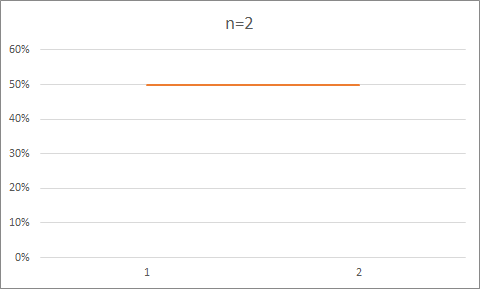
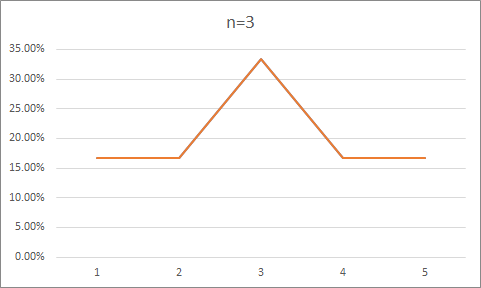
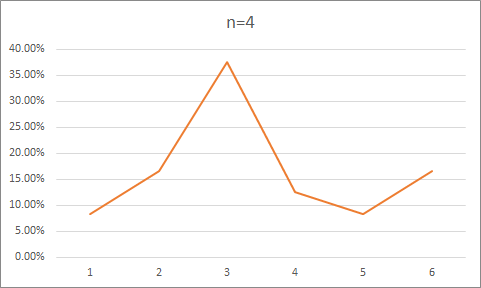
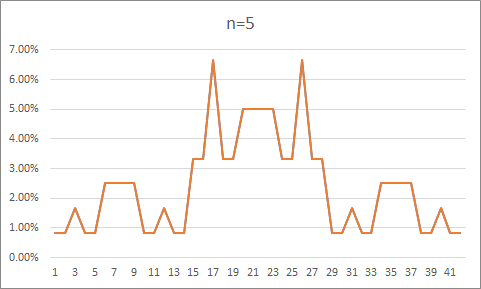
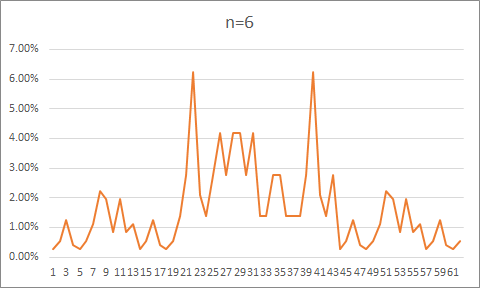
原始数据:
n=2
50%
50%
n=3
16.666666%
16.666666%
33.333332%
16.666666%
16.666666%
n=4
8.333333%
16.666666%
37.5%
12.5%
8.333333%
16.666666%
n=5
0.8333333%
0.8333333%
1.6666666%
0.8333333%
0.8333333%
2.5%
2.5%
2.5%
2.5%
0.8333333%
0.8333333%
1.6666666%
0.8333333%
0.8333333%
3.3333333%
3.3333333%
6.6666665%
3.3333333%
3.3333333%
5%
5%
5%
5%
3.3333333%
3.3333333%
6.6666665%
3.3333333%
3.3333333%
0.8333333%
0.8333333%
1.6666666%
0.8333333%
0.8333333%
2.5%
2.5%
2.5%
2.5%
0.8333333%
0.8333333%
1.6666666%
0.8333333%
0.8333333%
n=6
0.2777778%
0.5555556%
1.25%
0.41666666%
0.2777778%
0.5555556%
1.1111112%
2.2222223%
1.9444444%
0.8333333%
1.9444444%
0.8333333%
1.1111112%
0.2777778%
0.5555556%
1.25%
0.41666666%
0.2777778%
0.5555556%
1.3888888%
2.7777777%
6.25%
2.0833333%
1.3888888%
2.7777777%
4.1666665%
2.7777777%
4.1666665%
4.1666665%
2.7777777%
4.1666665%
1.3888888%
1.3888888%
2.7777777%
2.7777777%
1.3888888%
1.3888888%
1.3888888%
2.7777777%
6.25%
2.0833333%
1.3888888%
2.7777777%
0.2777778%
0.5555556%
1.25%
0.41666666%
0.2777778%
0.5555556%
1.1111112%
2.2222223%
1.9444444%
0.8333333%
1.9444444%
0.8333333%
1.1111112%
0.2777778%
0.5555556%
1.25%
0.41666666%
0.2777778%
0.5555556%
3.2.27
解答
二叉查找树的内存开销=对象开销+根结点引用+N个结点
=对象开销+根结点引用+N×(对象开销+父类型引用+左/右子树引用+键/值引用+结点数)
=16+8+N×(16+8+16+16+4+4)=24+64N 字节
BinarySearchST:对象开销+键/值数组引用+键/值数组+计数器(一个 int)。
=16+16+(16+4+4+8N)×2+4+4=88+16N 字节。
SequentialSearchST:对象开销+头结点引用+N个结点+计数器
=对象开销+头结点引用+N×(对象开销+父类型引用+next引用+键/值引用)+计数器
=16+8+N×(16+8+8+16)+4+4=32+48N 字节
示意图如下:

其中,对象开销 16 字节,其他均为引用,各占 8 字节。
《双城记》中不重复的单词有 26436 个(不包括最后的版权声明),全部是原文的子字符串,每个占 40 字节。
一个 Integer 占 24 字节,于是估计的内存消耗为:24+(64+40+24)×26436=3383832 字节。
3.2.28
解答
修改一下 Put 和 Get 方法,在实际操作之前先检查缓存是否符合要求,然后在操作之后更新缓存。
代码
private Node _cache;
public override TValue Get(TKey key)
{
if (_cache != null && _cache.Key.CompareTo(key) == 0)
{
return _cache.Value;
}
return Get(root, key).Value;
}
protected override Node Get(Node x, TKey key)
{
if (key == null)
{
throw new ArgumentNullException("calls get() with a null key");
}
if (x == null)
{
return null;
}
var cmp = key.CompareTo(x.Key);
if (cmp < 0)
{
return Get(x.Left, key);
}
else if (cmp > 0)
{
return Get(x.Right, key);
}
else
{
_cache = x;
return x;
}
}
public override void Put(TKey key, TValue value)
{
if (key == null)
{
throw new ArgumentNullException("calls Put() with a null key");
}
if (value == null)
{
Delete(key);
return;
}
if (_cache != null && _cache.Key.CompareTo(key) == 0)
{
_cache.Value = value;
return;
}
root = Put(root, key, value);
}
protected override Node Put(Node x, TKey key, TValue value)
{
if (x == null)
{
_cache = new Node(key, value, 1);
return _cache;
}
var cmp = key.CompareTo(x.Key);
if (cmp < 0)
x.Left = Put(x.Left, key, value);
else if (cmp > 0)
x.Right = Put(x.Right, key, value);
else
x.Value = value;
x.Size = 1 + Size(x.Left) + Size(x.Right);
return x;
}
另请参阅
3.2.29
解答
本题在原书后续印刷中已修改,这里仍采用中文版的题目。
部分解答:https://algs4.cs.princeton.edu/32bst/BST.java.html(isSizeConsistent())
如果根结点记录的结点数=左子树的结点数+右子树的结点数+1,就符合要求。
按照这个题意编制递归方法即可。
先写边界,当输入为 null 时,显然符合要求。
然后计算左子树的 Size 和右子树的 Size 加起来是否等于根结点的 Size + 1,
以及左子树和右子树是否符合同样的条件。
代码
protected static bool IsBinaryTree(Node x)
{
if (x == null)
{
return true; // 空树显然符合二叉树条件。
}
var size = 1; // 包括当前结点本身。
if (x.Left != null)
{
size += x.Left.Size;
}
if (x.Right != null)
{
size += x.Right.Size;
}
return IsBinaryTree(x.Left) &&
IsBinaryTree(x.Right) &&
x.Size == size;
}
另请参阅
3.2.30
解答
本题在原书后续印刷中已修改,这里仍然采用中文版的题目。
与上一题非常类似,条件有:
根结点必须在 min 和 max 范围内,
且左右子树要么不存在,要么小于/大于根结点的键,
左右子树同样满足上述条件。
代码
protected static bool IsOrdered(Node x, TKey min, TKey max)
{
if (x == null)
{
return true; // 空树显然是满足要求的。
}
return IsOrdered(x.Left, min, max) &&
IsOrdered(x.Right, min, max) && // 左右子树都满足要求。
x.Key.CompareTo(max) <= 0 &&
x.Key.CompareTo(min) >= 0 && // 当前结点位于范围内。
(x.Left == null || x.Left.Key.CompareTo(x.Key) < 0) &&
(x.Right == null || x.Right.Key.CompareTo(x.Key) > 0); // 当前结点与子结点满足大小关系。
}
另请参阅
3.2.31
解答
本题在原书后续印刷中已删除,这里仍然采用中文版的题目。
注意这个题并没有递归的要求,直接广度优先搜索即可,随时记录和检查已找到的键。
代码
protected static bool HasNoDuplicates(Node x)
{
var keys = new List<TKey>(); // 也可以用 HashSet 之类的数据结构提高效率。
var queue = new Queue<Node>();
queue.Enqueue(x);
while (queue.Count > 0)
{
var node = queue.Dequeue();
if (node == null)
{
continue;
}
if (keys.Contains(node.Key))
{
return false;
}
keys.Add(node.Key);
queue.Enqueue(node.Left);
queue.Enqueue(node.Right);
}
return true;
}
另请参阅
3.2.32
解答
本题在原书后续印刷中已修改,这里仍然采用中文版的题目。
官网解答见:https://algs4.cs.princeton.edu/32bst/BST.java.html (isBST())
书中已经给出了答案,当然在 Java 和 C# 里,&& 总是从左向右计算的,而且遇到 false 会直接返回结果。
如果数据结构中存在环,IsOrdered 有可能会陷入无限递归的情况,因此调用顺序比较重要。
代码
public static bool IsBST(BST<TKey, TValue> bst)
{
return IsBinaryTree(bst) &&
IsOrdered(bst) &&
HasNoDuplicates(bst);
}
另请参阅
Boolean logical operators (C# reference)
Equality, Relational, and Conditional Operators
3.2.33
解答
官网解答见:https://algs4.cs.princeton.edu/32bst/BST.java.html (isRankConsistent())
按照题目要求实现即可,分为两步进行测试。
代码
public static bool IsRankConsistent(BST<TKey, TValue> bst)
{
for (var i = 0; i < bst.Size(); i++)
{
if (i != bst.Rank(bst.Select(i)))
{
return false;
}
}
foreach (var key in bst.Keys())
{
if (key.CompareTo(bst.Select(bst.Rank(key))) != 0)
{
return false;
}
}
return true;
}
另请参阅
3.2.34
解答
其实就是将所有的结点按照中序序列排成了一个双向链表,对树进行修改时要同时更新这个双向链表。
当插入新结点时,插到左侧的结点会变为父结点的新前驱,同理右侧会变为新后继。
注意要更新父结点原来的前驱和后继结点(如果有)。
删除结点时较为简单,只要更新需要删除结点的前驱和后继结点即可。
原本操作 left 和 right 的代码不需要更改,只需要加上对 prev 和 next 做操作的代码即可。
Prev 方法实现如下(Next 类似),修改了内部的 Get 方法使之返回 Node 而非 TValue。
public TKey Prev(TKey key)
{
var node = Get(root, key);
if (node == null || node.Prev == null)
return null;
return node.Prev.Key;
}
代码
处理结点关系的几个方法。
private void DeleteNode(Node x)
{
if (x.Prev != null)
x.Prev.Next = x.Next;
if (x.Next != null)
x.Next.Prev = x.Prev;
}
private void InsertRight(Node parent, Node newNode)
{
parent.Right = newNode;
InsertBetween(parent, newNode, parent.Next);
}
private void InsertLeft(Node parent, Node newNode)
{
parent.Left = newNode;
InsertBetween(parent.Prev, newNode, parent);
}
private void InsertBetween(Node prev, Node newNode, Node next)
{
newNode.Prev = prev;
newNode.Next = next;
if (prev != null)
prev.Next = newNode;
if (next != null)
next.Prev = newNode;
}
Put 方法
protected virtual Node Put(Node x, TKey key, TValue value)
{
if (x == null)
{
return new Node(key, value, 1); // 树是空的。
}
var cmp = key.CompareTo(x.Key);
if (cmp < 0)
{
if (x.Left == null)
{
var newNode = new Node(key, value, 1);
InsertLeft(x, newNode);
}
else
{
x.Left = Put(x.Left, key, value);
}
}
else if (cmp > 0)
{
if (x.Right == null)
{
var newNode = new Node(key, value, 1);
InsertRight(x, newNode);
}
else
{
x.Right = Put(x.Right, key, value);
}
}
else
{
x.Value = value;
}
x.Size = 1 + Size(x.Left) + Size(x.Right);
return x;
}
Delete 方法
protected virtual Node Delete(Node x, TKey key)
{
if (x == null)
return null;
var cmp = key.CompareTo(x.Key);
if (cmp < 0)
x.Left = Delete(x.Left, key);
else if (cmp > 0)
x.Right = Delete(x.Right, key);
else
{
DeleteNode(x); // 在中序链表中删除结点。
if (x.Right == null)
return x.Left;
if (x.Left == null)
return x.Right;
var t = x;
x = Min(t.Right);
x.Right = DeleteMin(t.Right);
x.Left = t.Left;
}
x.Size = Size(x.Left) + Size(x.Right) + 1;
return x;
}
DeleteMin 方法,DeleteMax 类似。
protected virtual Node DeleteMin(Node x)
{
if (x.Left == null)
{
DeleteNode(x);
return x.Right;
}
x.Left = DeleteMin(x.Left);
x.Size = Size(x.Left) + Size(x.Right) + 1;
return x;
}
另请参阅
3.2.35
解答
根据书中已经给出的归纳关系式(中文版P255/英文版P403):
整理得:
这和快速排序的式子基本一致,只是 $ N+1 $ 变成了 $ N-1 $。
遵循相同的推导过程,我们可以获得类似的结果,两边同乘以 $ N $:
用 $ N+1 $ 时的等式减去该式得:
令 $ T_N = \frac{C_N}{N+1} $,得到:
归纳得:
于是平均成本为:\(1+C_N/N \sim 2\ln N+2\gamma-3\) 。
3.2.36
解答
用一个栈来模拟递归即可,将路径上的结点记录到栈里。
注意 Queue<TKey> 不算额外空间,因为它在keys执行完毕之后不会被回收。
代码
private void Keys(Node x, Queue<TKey> queue, TKey lo, TKey hi)
{
var stack = new Stack<Node>();
while (x != null || stack.Count > 0)
{
if (x != null)
{
var cmpLo = lo.CompareTo(x.Key);
var cmpHi = hi.CompareTo(x.Key);
if (cmpHi >= 0)
stack.Push(x);
if (cmpLo < 0)
x = x.Left;
else
x = null;
}
else
{
x = stack.Pop();
var cmpLo = lo.CompareTo(x.Key);
var cmpHi = hi.CompareTo(x.Key);
if (cmpLo <= 0 && cmpHi >= 0)
queue.Enqueue(x.Key);
x = x.Right;
}
}
}
另请参阅
3.2.37
解答
二叉树层序遍历,出队一个结点,打印它,将结点的左右子树入队,循环即可。
代码
private void PrintLevel(Node x)
{
var queue = new Queue<Node>();
queue.Enqueue(x);
while (queue.Count > 0)
{
var node = queue.Dequeue();
if (node.Left != null)
queue.Enqueue(node.Left);
if (node.Right != null)
queue.Enqueue(node.Right);
Console.Write(node.Key + ", ");
}
}
另请参阅
3.2.38
解答
通过层序遍历计算结点的坐标,然后绘制即可。
先算出最大深度,确定每一层的高度 Y,
再将每一层的宽度分成 \(2^n-1\) 份,从左到右依次对结点赋值。
效果如下:
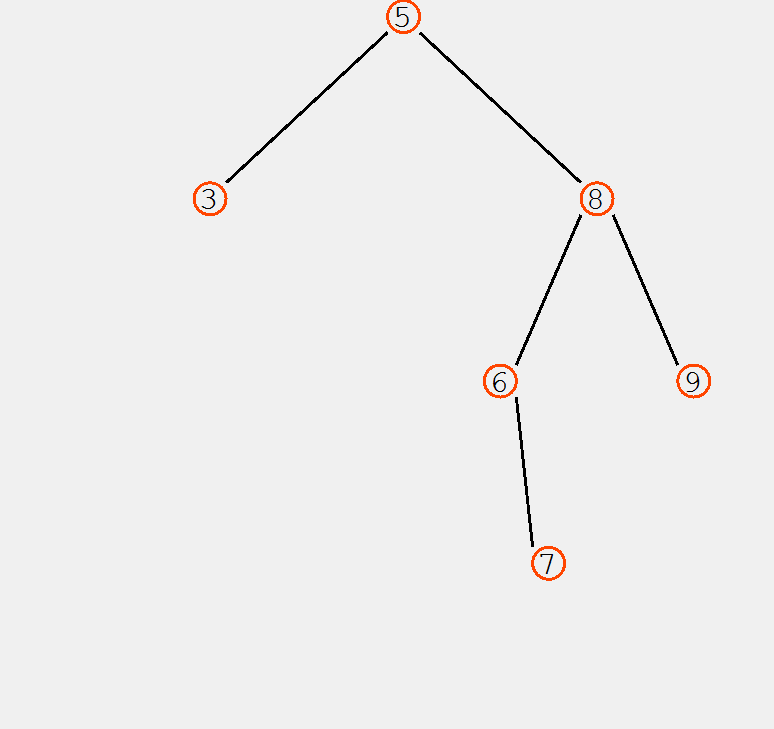
代码
计算坐标的函数。
public void DrawTree(Graphics pen, RectangleF panel)
{
var depth = Depth(root); // 确定最大深度。
var layerHeight = panel.Height / depth;
var nowLayer = new Queue<Node>();
var nextLayer = new Queue<Node>();
nextLayer.Enqueue(root);
for (var layer = 0; layer != depth; layer++)
{
var unitSizeX = (float)(panel.Width / Math.Pow(2, layer));
var temp = nowLayer;
nowLayer = nextLayer;
nextLayer = temp;
var cursorX = 0.0f;
var cursorY = layer * layerHeight;
while (nowLayer.Count != 0)
{
var node = nowLayer.Dequeue();
if (node != null)
{
nextLayer.Enqueue(node.Left);
nextLayer.Enqueue(node.Right);
}
else
{
nextLayer.Enqueue(null);
nextLayer.Enqueue(null);
}
if (node != null)
{
node.X = cursorX + unitSizeX / 2.0f;
node.Y = cursorY;
}
cursorX += unitSizeX;
}
}
}
3.2.39
解答
测试结果:

可以看到和公式给出的结果十分一致。
测试时先生成 0~2n 顺序序列,奇数插入二叉树中,偶数用于测试查找失败的情况。
代码
static void Main(string[] args)
{
var n = 10000;
var trial = 100;
for (var i = 0; i < 3; i++)
{
var odds = new int[n];
var evens = new int[n];
var bst = new BSTAnalysis<int, int>();
for (var j = 100; j < n; j++)
{
evens[j] = j;
odds[j] = j + 1;
}
Shuffle(odds);
foreach (var item in odds)
{
bst.Put(item, item);
}
Console.WriteLine("n:" + n);
// hit
Shuffle(odds);
Test(bst, odds, trial, "hit");
// miss
Shuffle(evens);
Test(bst, evens, trial, "miss");
n *= 10;
}
}
static void Test(BSTAnalysis<int, int> bst, int[] testCases, int trials, string label)
{
var testRecords = new long[trials];
for (var j = 0; j < trials; j++)
{
bst.CompareTimes = 0; // reset
bst.Get(testCases[j]); // test
testRecords[j] = bst.CompareTimes; // record
}
var testAverage = 0d; // 'd' for double
foreach (var record in testRecords)
{
testAverage += record;
}
testAverage /= testRecords.Length;
var testStandardDeviation = 0d;
foreach (var record in testRecords)
{
testStandardDeviation += (record - testAverage) * (record - testAverage);
}
testStandardDeviation /= testRecords.Length;
testStandardDeviation = Math.Sqrt(testStandardDeviation);
// 2lnN + 2γ - 3
var expect = 2 * Math.Log(testCases.Length) + 2 * 0.5772156649 - 3;
Console.WriteLine(label + ": ActualAverage: " + testAverage + "\tExpectAverage: " + expect + "\tStandardDevitation:" + testStandardDeviation);
}
static void Shuffle<T>(T[] a)
{
var random = new Random();
for (var i = 0; i < a.Length; i++)
{
var r = i + random.Next(a.Length - i);
var temp = a[i];
a[i] = a[r];
a[r] = temp;
}
}
另请参阅
3.2.40
解答
书中的结论是 1986 年 L. Devroye 给出的,原式为 \(H_n \rightarrow c\log(n)\)。
其中 \(c\) 是方程 \(c\log \frac{2e}{c}=1\) 的最大解,约为 \(4.31107\)。
2002 年 Michael Drmota 给出了一个跟精确的公式:\(\mathrm{E}(H_n)=c\log n-\frac{3c}{2(c-1)}\log \log n + O(1)\)。
测试结果如下,误差基本稳定在一个常数。
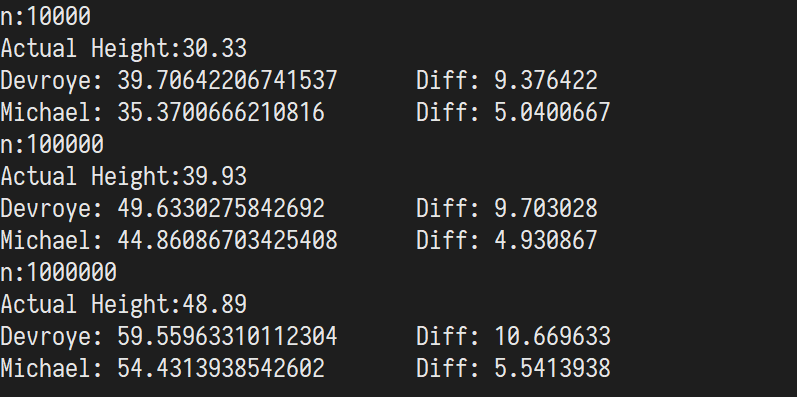
代码
static void Main(string[] args)
{
var n = 10000;
var trials = 100;
for (var i = 0; i < 3; i++)
{
var items = new int[n];
for (var j = 0; j < n; j++)
{
items[j] = j;
}
var aveHeight = 0d;
for (var j = 0; j < trials; j++)
{
var bst = new BST<int, int>();
Shuffle(items);
foreach (var item in items)
{
bst.Put(item, item);
}
aveHeight += bst.Height();
}
aveHeight /= trials;
var c = 4.31107d;
var expectHeightLuc = c * Math.Log(n);
var expectHeightMichael = c * Math.Log(n) - (3 * c / (2 * (c - 1))) * Math.Log(Math.Log(n));
Console.WriteLine("n:" + n);
Console.WriteLine("Actual Height:" + aveHeight);
Console.WriteLine("Devroye: " + expectHeightLuc + "\tDiff: " + (float)(expectHeightLuc - aveHeight));
Console.WriteLine("Michael: " + expectHeightMichael + "\tDiff: " + (float)(expectHeightMichael - aveHeight));
n *= 10;
}
}
static void Shuffle<T>(T[] a)
{
var random = new Random();
for (var i = 0; i < a.Length; i++)
{
var r = i + random.Next(a.Length - i);
var temp = a[i];
a[i] = a[r];
a[r] = temp;
}
}
另请参阅
A note on the height of binary search tree
Note The Variance of the height of binary search trees
3.2.41
解答
大体上和标准 BST 实现差不多,做如下变换即可:
x.Key => _nodes[x].Key;
x.Value => _nodes[x].Value;
x.Left => _left[x];
x.Right => _right[x];
由于使用了数组,在正常「删除」二叉树结点之后,还需要手工「垃圾回收」,如下图所示:
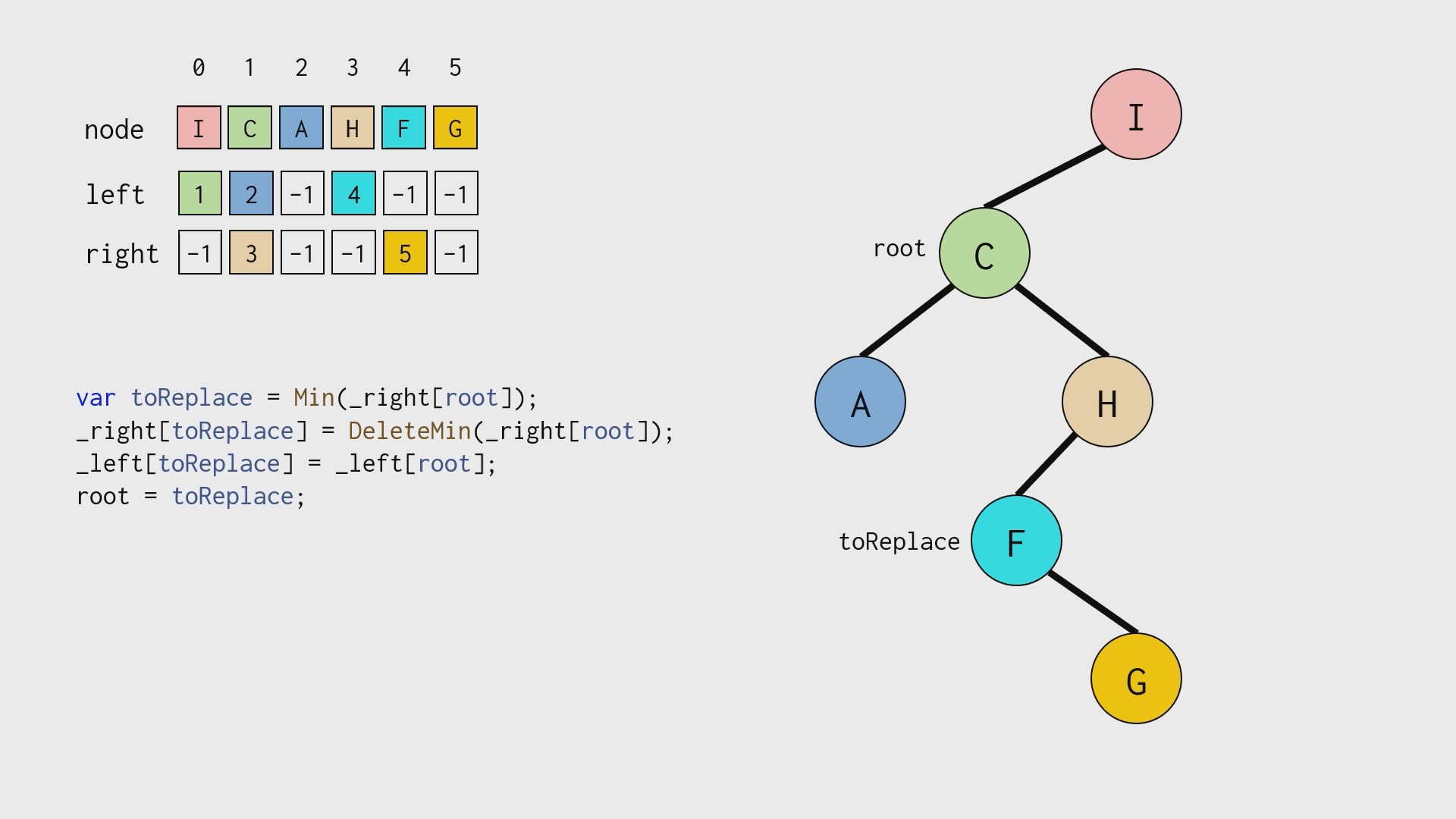
性能比较:
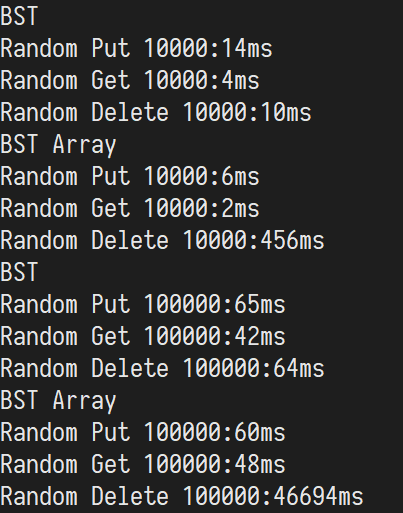
可见数组实现在删除节点时有巨大的性能差距。
代码
private readonly Node[] _nodes;
private readonly int[] _left;
private readonly int[] _right;
private int _size;
private int _root;
/// <summary>
/// 二叉搜索树的结点。
/// </summary>
private class Node
{
public TKey Key { get; set; }
public TValue Value { get; set; }
}
/// <summary>
/// 建立一个以数组为基础的二叉搜索树。
/// </summary>
/// <param name="maxSize">二叉搜索树中的结点数。</param>
public BSTArray(int maxSize)
{
_nodes = new Node[maxSize];
_left = new int[maxSize];
_right = new int[maxSize];
for (var i = 0; i < maxSize; i++)
{
_left[i] = -1;
_right[i] = -1;
}
_size = 0;
_root = 0;
}
/// <summary>
/// 向符号表插入键值对。
/// </summary>
/// <param name="key">键。</param>
/// <param name="value">值。</param>
public void Put(TKey key, TValue value)
{
if (_size == _nodes.Length)
{
throw new InvalidOperationException("BST is full");
}
if (IsEmpty())
{
_nodes[_size] = new Node{Key = key, Value = value};
_size++;
return;
}
Put(key, value, null, _root);
}
/// <summary>
/// 向二叉树插入键值对。
/// </summary>
/// <param name="key">键。</param>
/// <param name="value">值。</param>
/// <param name="treeSide">子树数组。</param>
/// <param name="parent">父结点下标。</param>
private void Put(TKey key, TValue value, int[] treeSide, int parent)
{
int now;
if (treeSide == null) // init
{
now = parent;
}
else if (treeSide[parent] == -1) // finish
{
_nodes[_size] = new Node { Key = key, Value = value };
treeSide[parent] = _size;
_size++;
return;
}
else
{
now = treeSide[parent];
}
var cmp = _nodes[now].Key.CompareTo(key);
if (cmp > 0)
{
Put(key, value, _left, now);
}
else if (cmp < 0)
{
Put(key, value, _right, now);
}
else
{
_nodes[now].Value = value;
}
}
/// <summary>
/// 获取键 <paramref name="key"/> 对应的值,不存在则返回 <c>default(Value)</c>。
/// </summary>
/// <param name="key">键。</param>
/// <returns>键 <paramref name="key"/> 对应的值,不存在则返回 <c>default(Value)</c>。</returns>
public TValue Get(TKey key)
{
var indices = Get(key, _root);
if (indices == -1)
{
return default;
}
return _nodes[indices].Value;
}
/// <summary>
/// 获取 <paramref name="key"/> 对应的下标,不存在则返回 -1。
/// </summary>
/// <param name="key">键。</param>
/// <param name="start">起始搜索下标。</param>
/// <returns>找到则返回对应下标,否则返回 -1。</returns>
private int Get(TKey key, int start)
{
var now = start;
while (now != -1)
{
var cmp = _nodes[now].Key.CompareTo(key);
if (cmp > 0)
{
now = _left[now];
}
else if (cmp < 0)
{
now = _right[now];
}
else
{
return now;
}
}
return -1;
}
/// <summary>
/// 从表中删去键 <paramref name="key"/> 及其对应的值。
/// </summary>
/// <param name="key">要删除的键。</param>
public void Delete(TKey key)
{
var toDelete = Get(key, _root);
if (toDelete == -1)
{
throw new InvalidOperationException("No Such Key in BST");
}
_root = Delete(key, _root);
RemoveNode(toDelete);
}
/// <summary>
/// 从根结点为 <paramref name="root"/> 的二叉搜索树中删除键为 <paramref name="key"/> 的结点。
/// 返回删除结点后树的根结点下标。
/// </summary>
/// <param name="key">要删除的键。</param>
/// <param name="root">根结点。</param>
/// <returns>删除结点后树的根结点下标。</returns>
private int Delete(TKey key, int root)
{
if (root == -1 || _nodes[root] == null)
{
return -1;
}
var cmp = _nodes[root].Key.CompareTo(key);
if (cmp > 0)
{
_left[root] = Delete(key, _left[root]);
}
else if (cmp < 0)
{
_right[root] = Delete(key, _right[root]);
}
else
{
if (_left[root] == -1)
{
return _right[root];
}
if (_right[root] == -1)
{
return _left[root];
}
var toReplace = Min(_right[root]);
_right[toReplace] = DeleteMin(_right[root]);
_left[toReplace] = _left[root];
root = toReplace;
}
return root;
}
/// <summary>
/// 键 <paramref name="key"/> 在表中是否存在对应的值。
/// </summary>
/// <param name="key">键。</param>
/// <returns>如果存在则返回 <c>true</c>,否则返回 <c>false</c>。</returns>
public bool Contains(TKey key)
{
return Get(key, _root) > -1;
}
/// <summary>
/// 符号表是否为空。
/// </summary>
/// <returns>为空则返回 <c>true</c>,否则返回 <c>false</c>。</returns>
public bool IsEmpty()
{
return _size == 0;
}
/// <summary>
/// 获得符号表中键值对的数量。
/// </summary>
/// <returns>符号表中键值对的数量。</returns>
public int Size()
{
return _size;
}
/// <summary>
/// [<paramref name="lo"/>, <paramref name="hi"/>] 之间键的数量。
/// </summary>
/// <param name="lo">范围起点。</param>
/// <param name="hi">范围终点。</param>
/// <returns>[<paramref name="lo"/>, <paramref name="hi"/>] 之间键的数量。</returns>
public int Size(TKey lo, TKey hi)
{
return Keys(lo, hi).Count();
}
/// <summary>
/// 计算以 <paramref name="root"/> 为根结点的二叉树的大小。
/// </summary>
/// <param name="root">二叉树的根结点下标。</param>
/// <returns>二叉树中的结点个数。</returns>
private int Size(int root)
{
if (root == -1)
{
return 0;
}
return 1 + Size(_left[root]) + Size(_right[root]);
}
/// <summary>
/// 获得符号表中所有键的集合。
/// </summary>
/// <returns>符号表中所有键的集合。</returns>
public IEnumerable<TKey> Keys()
{
if (IsEmpty())
{
return new List<TKey>();
}
return Keys(Min(), Max());
}
/// <summary>
/// 获得符号表中 [<paramref name="lo"/>, <paramref name="hi"/>] 之间的键。
/// </summary>
/// <param name="lo">范围起点。</param>
/// <param name="hi">范围终点。</param>
/// <returns>符号表中 [<paramref name="lo"/>, <paramref name="hi"/>] 之间的键。</returns>
public IEnumerable<TKey> Keys(TKey lo, TKey hi)
{
if (lo == null)
throw new ArgumentNullException("first argument to keys() is null");
if (hi == null)
throw new ArgumentNullException("second argument to keys() is null");
var queue = new Queue<TKey>();
Keys(_root, queue, lo, hi);
return queue;
}
/// <summary>
/// 获取二叉查找树中在 <paramref name="lo"/> 和 <paramref name="hi"/> 之间的所有键。
/// </summary>
/// <param name="x">二叉查找树的根结点。</param>
/// <param name="queue">要填充的队列。</param>
/// <param name="lo">键的下限。</param>
/// <param name="hi">键的上限。</param>
private void Keys(int x, Queue<TKey> queue, TKey lo, TKey hi)
{
if (x == -1)
{
return;
}
var cmplo = lo.CompareTo(_nodes[x].Key);
var cmphi = hi.CompareTo(_nodes[x].Key);
if (cmplo < 0)
{
Keys(_left[x], queue, lo, hi);
}
if (cmplo <= 0 && cmphi >= 0)
{
queue.Enqueue(_nodes[x].Key);
}
if (cmphi > 0)
{
Keys(_right[x], queue, lo, hi);
}
}
/// <summary>
/// 最小的键。
/// </summary>
/// <returns>最小的键。</returns>
public TKey Min()
{
if (IsEmpty())
{
throw new InvalidOperationException("BST is Empty!");
}
return _nodes[Min(_root)].Key;
}
/// <summary>
/// 在二叉查找树中查找包含最小键的结点。
/// </summary>
/// <param name="x">二叉查找树的根结点。</param>
/// <returns>包含最小键的结点。</returns>
private int Min(int x)
{
if (_left[x] == -1)
{
return x;
}
return Min(_left[x]);
}
/// <summary>
/// 最大的键。
/// </summary>
/// <returns>最大的键。</returns>
public TKey Max()
{
if (IsEmpty())
{
throw new InvalidOperationException("BST is Empty!");
}
return _nodes[Max(_root)].Key;
}
/// <summary>
/// 在二叉查找树中查找包含最大键的结点。
/// </summary>
/// <param name="x">二叉查找树的根结点。</param>
/// <returns>包含最大键的结点。</returns>
private int Max(int x)
{
if (_right[x] == -1)
{
return x;
}
return Max(_right[x]);
}
/// <summary>
/// 小于等于 <paramref name="key"/> 的最大值。
/// </summary>
/// <returns>小于等于 <paramref name="key"/> 的最大值。</returns>
public TKey Floor(TKey key)
{
if (key == null)
{
throw new ArgumentNullException("argument to floor is null");
}
if (IsEmpty())
{
throw new InvalidOperationException("calls floor with empty symbol table");
}
var x = Floor(_root, key);
if (x == -1)
{
return default;
}
else
{
return _nodes[x].Key;
}
}
/// <summary>
/// 获得符号表中小于等于 <paramref name="key"/> 的最大结点。
/// </summary>
/// <param name="x">二叉查找树的根结点。</param>
/// <param name="key">键。</param>
/// <returns>小于等于 <paramref name="key"/> 的最大结点。</returns>
private int Floor(int x, TKey key)
{
if (x == -1)
{
return -1;
}
var cmp = key.CompareTo(_nodes[x].Key);
if (cmp == 0)
{
return x;
}
else if (cmp < 0)
{
return Floor(_left[x], key);
}
var t = Floor(_right[x], key);
if (t != -1)
{
return t;
}
return x;
}
/// <summary>
/// 大于等于 <paramref name="key"/> 的最小值。
/// </summary>
/// <returns>大于等于 <paramref name="key"/> 的最小值。</returns>
public TKey Ceiling(TKey key)
{
if (key == null)
{
throw new ArgumentNullException("argument to ceiling is null");
}
if (IsEmpty())
{
throw new InvalidOperationException("calls ceiling with empty symbol table");
}
var x = Ceiling(_root, key);
if (x == -1)
{
return default;
}
return _nodes[x].Key;
}
/// <summary>
/// 获取符号表中大于等于 <paramref name="key"/> 的最小结点。
/// </summary>
/// <param name="x">二叉查找树的根结点。</param>
/// <param name="key">键。</param>
/// <returns>符号表中大于等于 <paramref name="key"/> 的最小结点。</returns>
private int Ceiling(int x, TKey key)
{
if (x == -1)
{
return -1;
}
var cmp = key.CompareTo(_nodes[x].Key);
if (cmp == 0)
{
return x;
}
if (cmp < 0)
{
var t = Ceiling(_left[x], key);
if (t != -1)
{
return t;
}
return x;
}
return Ceiling(_right[x], key);
}
/// <summary>
/// 小于 <paramref name="key"/> 的键的数量。
/// </summary>
/// <returns>小于 <paramref name="key"/> 的键的数量。</returns>
public int Rank(TKey key)
{
if (key == null)
{
throw new ArgumentNullException("argument to rank() is null");
}
return Rank(_root, key);
}
/// <summary>
/// 返回 <paramref name="key"/> 在二叉查找树中的排名。
/// </summary>
/// <param name="x">二叉查找树的根结点。</param>
/// <param name="key">要查找排名的键。</param>
/// <returns><paramref name="key"/> 的排名。</returns>
private int Rank(int x, TKey key)
{
if (x == -1)
{
return 0;
}
var cmp = key.CompareTo(_nodes[x].Key);
if (cmp < 0)
{
return Rank(_left[x], key);
}
else if (cmp > 0)
{
return 1 + Size(_left[x]) + Rank(_right[x], key);
}
else
{
return Size(_left[x]);
}
}
/// <summary>
/// 获得排名为 k 的键。
/// </summary>
/// <param name="k">需要获得的键的排名。</param>
/// <returns>排名为 k 的键。</returns>
public TKey Select(int k)
{
if (k < 0 || k >= Size())
{
throw new ArgumentException("argument to select() is invaild: " + k);
}
var x = Select(_root, k);
return _nodes[x].Key;
}
/// <summary>
/// 挑拣出排名为 <paramref name="k"/> 的结点。
/// </summary>
/// <param name="x">树的根结点。</param>
/// <param name="k">要挑拣的排名。</param>
/// <returns>排名为 <paramref name="k"/> 的结点。</returns>
private int Select(int x, int k)
{
if (x == -1)
{
return -1;
}
var t = Size(_left[x]);
if (t > k)
{
return Select(_left[x], k);
}
else if (t < k)
{
return Select(_right[x], k - t - 1);
}
else
{
return x;
}
}
/// <summary>
/// 删除最小的键。
/// </summary>
public void DeleteMin()
{
if (IsEmpty())
{
throw new InvalidOperationException("Symbol table underflow");
}
var minIndex = Min(_root);
_root = DeleteMin(_root);
RemoveNode(minIndex);
}
/// <summary>
/// 在以 <paramref name="x"/> 为根结点的二叉查找树中删除最小结点。
/// </summary>
/// <param name="x">二叉查找树的根结点。</param>
/// <returns>删除后的二叉查找树。</returns>
private int DeleteMin(int x)
{
if (_left[x] == -1)
{
return _right[x];
}
_left[x] = DeleteMin(_left[x]);
return x;
}
/// <summary>
/// 删除最大的键。
/// </summary>
public void DeleteMax()
{
if (IsEmpty())
{
throw new InvalidOperationException("Symbol table underflow");
}
var maxIndex = Max(_root);
_root = DeleteMax(_root);
RemoveNode(maxIndex);
}
/// <summary>
/// 从指定二叉查找树中删除最大结点。
/// </summary>
/// <param name="x">二叉查找树的根结点。</param>
/// <returns>删除后的二叉查找树。</returns>
private int DeleteMax(int x)
{
if (_right[x] == -1)
return _left[x];
_right[x] = DeleteMax(_right[x]);
return x;
}
/// <summary>
/// 删除下标为 <paramref name="index"/> 的结点。
/// </summary>
/// <param name="index">要删除的结点下标。</param>
private void RemoveNode(int index)
{
_size--;
// Remove Node
for (var i = index; i < _size; i++)
{
_nodes[i] = _nodes[i + 1];
_left[i] = _left[i + 1];
_right[i] = _right[i + 1];
}
// Adjust Index
if (_root >= index)
{
_root--;
}
for (var i = 0; i < _size; i++)
{
if (_left[i] >= index)
{
_left[i]--;
}
if (_right[i] >= index)
{
_right[i]--;
}
}
}
另请参阅
3.2.42
解答
按照题意实现即可,关键点有两个:
一是选择前驱的实现方式,只要选择左子树中的最大结点即可。
if (_random.NextDouble() < 0.5)
{
x = Min(t.Right);
x.Right = DeleteMin(t.Right);
x.Left = t.Left;
}
else
{
x = Max(t.Left);
x.Left = DeleteMax(t.Left);
x.Right = t.Right;
}
二是内部路径长度的计算方式,需要用层序遍历把所有结点的深度加起来。
var internalPath = 0;
var nowLayer = new Queue<Node>();
var nextLayer = new Queue<Node>();
nextLayer.Enqueue(root);
var depth = 0;
while (nextLayer.Count > 0)
{
var temp = nowLayer;
nowLayer = nextLayer;
nextLayer = temp;
while (nowLayer.Count > 0)
{
var node = nowLayer.Dequeue();
if (node.Left != null)
{
nextLayer.Enqueue(node.Left);
}
if (node.Right != null)
{
nextLayer.Enqueue(node.Right);
}
internalPath += depth;
}
depth++;
}
return internalPath;
结果如下:
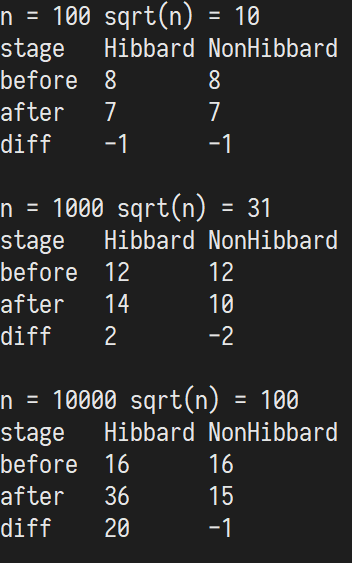
另请参阅
3.2.43
解答
依照题意实现即可,put/get 大约 10 倍差距。

MostFrequentlyKey 的实现:
public static TKey MostFrequentlyKey<TKey>(IST<TKey, int> st, TKey[] keys)
{
foreach (var s in keys)
{
if (st.Contains(s))
st.Put(s, st.Get(s) + 1);
else
st.Put(s, 1);
}
var max = keys[0];
foreach (var s in st.Keys())
if (st.Get(s) > st.Get(max))
max = s;
return max;
}
另请参阅
3.2.44
解答
使用类似于 3.1.38 的方法进行绘图,当 n=10000 时的结果如下:

代码
绘图部分:
public void Draw(long[] data)
{
var panel = CreateGraphics();
var unitX = (float)ClientRectangle.Width / data.Length;
var unitY = (float)ClientRectangle.Height / data.Max();
var accumulation = 0f; // f = float
for (var i = 0; i < data.Length; i++)
{
// Gray
panel.FillEllipse(Brushes.Gray, (i + 1) * unitX, ClientRectangle.Bottom - data[i] * unitY, 2, 2);
// Red
panel.FillEllipse(Brushes.Red, (i + 1) * unitX, ClientRectangle.Bottom - accumulation / (i + 1) * unitY, 2, 2);
accumulation += data[i];
}
panel.DrawString($"n:{data.Length}\nave:{accumulation / data.Length}", SystemFonts.DefaultFont, Brushes.Red, 0, 0);
}
测试部分:
private long[] Test(int n)
{
var testCases = new long[n];
var testResult = new long[n];
for (var i = 0; i < n; i++)
{
testCases[i] = i;
}
Shuffle(testCases);
var bst = new BSTAnalysis<long, int>();
for (var i = 0; i < n; i++)
{
bst.CompareTimes = 0;
bst.Put(testCases[i], 1);
testResult[i] = bst.CompareTimes;
}
return testResult;
}
static void Shuffle<T>(T[] a)
{
var random = new Random();
for (var i = 0; i < a.Length; i++)
{
var r = i + random.Next(a.Length - i);
var temp = a[i];
a[i] = a[r];
a[r] = temp;
}
}
另请参阅
3.2.45
解答
结果如下,可参考 3.1.39。
SequentialSearchST

BinarySearchST

BST
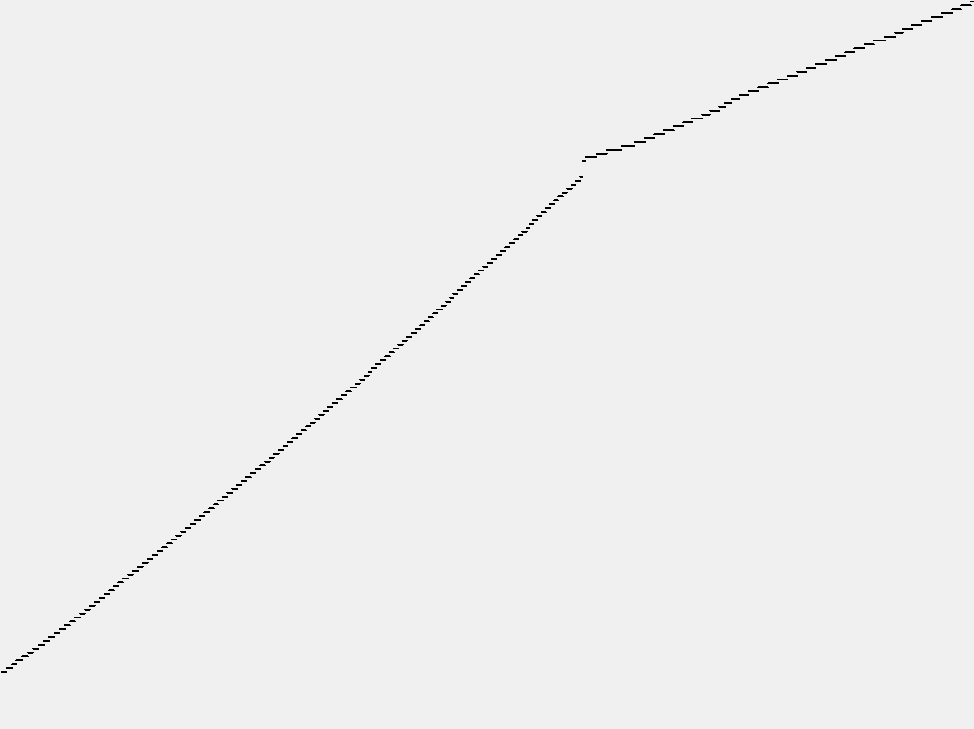
可以看到 BST 的曲线更为平滑,插入和查找部分耗时十分接近。
另请参阅
3.2.46
解答
翻译有些问题,其实指的是用 N 个 double 构造一个 BST 和 BinarySearchST 的速度对比。
Get 速度 BST 是不会比 BinarySearchST 快的。(\(1.39\lg N\) > \(\lg N\))
二叉搜索树一次查找平均需要 \(1.39\lg N\) 次比较,二分查找则是 \(N/2\),于是可以求得开销:
二叉查找树:\(1.39 \sum_{i=1}^{N-1} \lg i=1.39 \lg (N-1)!=1.39(N-1)\lg(N-1)\)。
二分查找实现的符号表:\(1/2+2/2+ \cdots+(N-1)/2=N(N-1)/4\) 。
令两式相等,可以求得快 10 倍,100 倍,1000 倍的 \(N\) 值。
例如快 10 倍的方程:
这是一个超越方程,可以简单用程序穷举出一个数值解。
for (var i = 0d; i < int.MaxValue; i++)
{
if (13.9 * Math.Log2(i - 1) < i / 4)
{
Console.WriteLine(i);
return;
}
}
解得的三个 N 值分别为 499,7115,91651。
除了基本的新元素赋值外,二叉树在插入时只需要进行比较即可。
但二分查找实现的符号表还需要维持数组有序,需要额外的赋值操作。
因此二分查找实现的符号表和二叉搜索树的开销如下:

其中 Array 包含了比较和额外的赋值次数,Tree 只有比较次数。
一般我们认为比较(Compare)和赋值(=)开销是一样的,但实际上比较会慢 6 倍左右(.net core 3.1),因此如果直接进行计时测试,可能得不出快 10 倍/100 倍/1000 倍的结果。
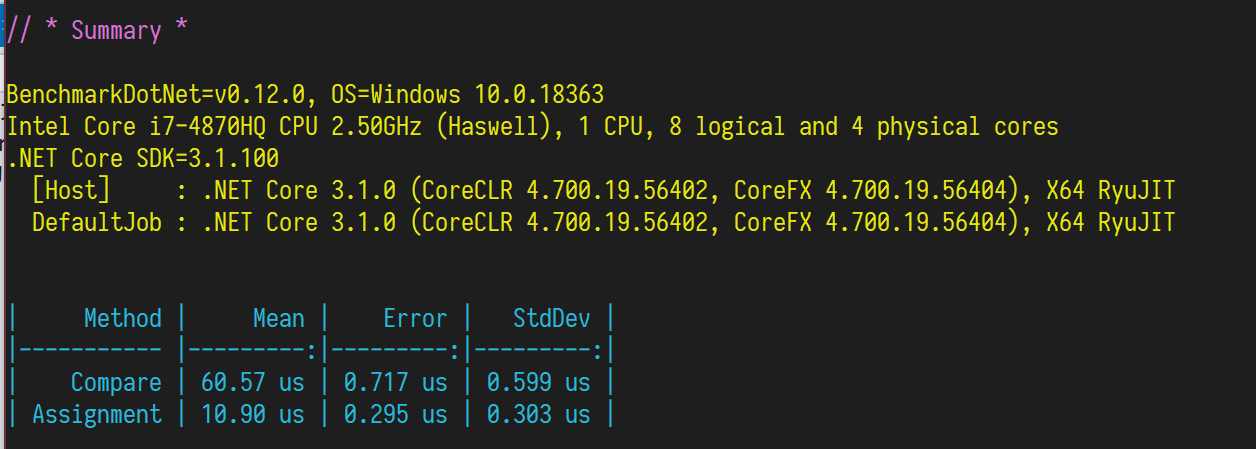
另请参阅
3.2.47
解答
如下图所示,内部路径平均长度是比较符合规律的:

方差:
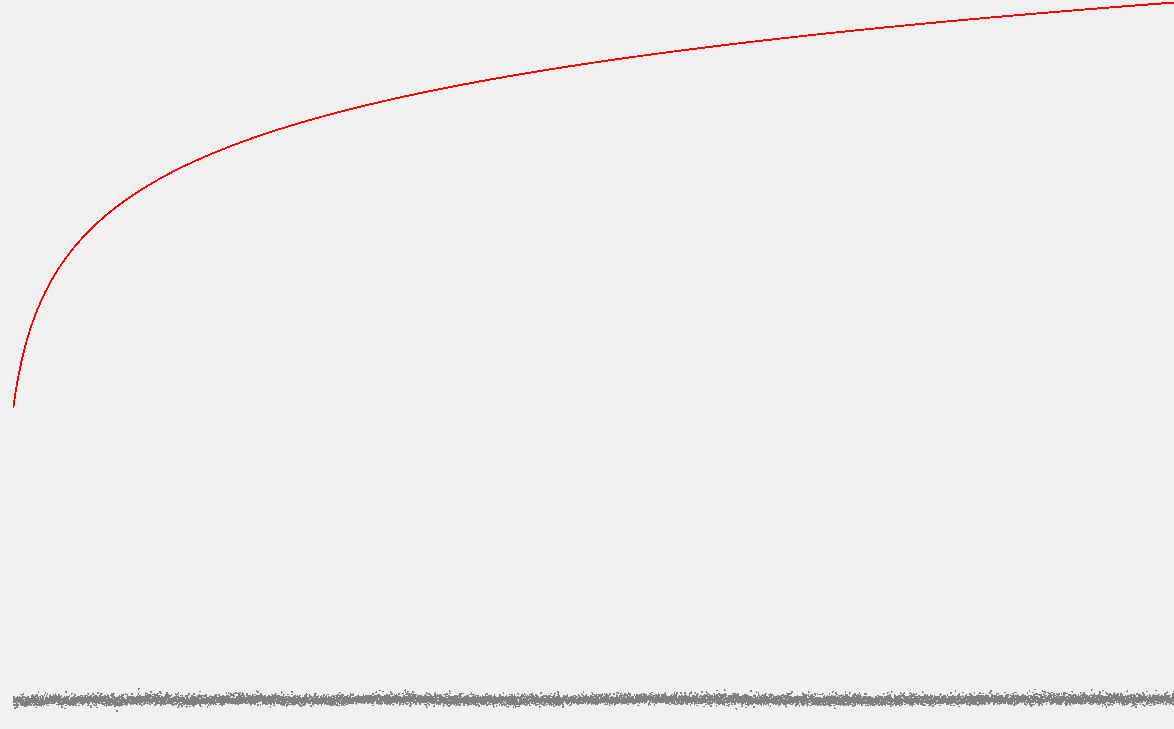
代码
一次测试:
private int Test(int n)
{
var data = GetRandomInt(n);
var bst = new BST<int, int>();
foreach (var d in data)
{
bst.Put(d, d);
}
return bst.AverageInternalPathLength();
}
求解内部路径长度:
public int AverageInternalPathLength() => InternalPath() / Size() + 1;
private int InternalPath()
{
var internalPath = 0;
var nowLayer = new Queue<Node>();
var nextLayer = new Queue<Node>();
nextLayer.Enqueue(root);
var depth = 0;
while (nextLayer.Count > 0)
{
var temp = nowLayer;
nowLayer = nextLayer;
nextLayer = temp;
while (nowLayer.Count > 0)
{
var node = nowLayer.Dequeue();
if (node.Left != null)
{
nextLayer.Enqueue(node.Left);
}
if (node.Right != null)
{
nextLayer.Enqueue(node.Right);
}
internalPath += depth;
}
depth++;
}
return internalPath;
}

 浙公网安备 33010602011771号
浙公网安备 33010602011771号